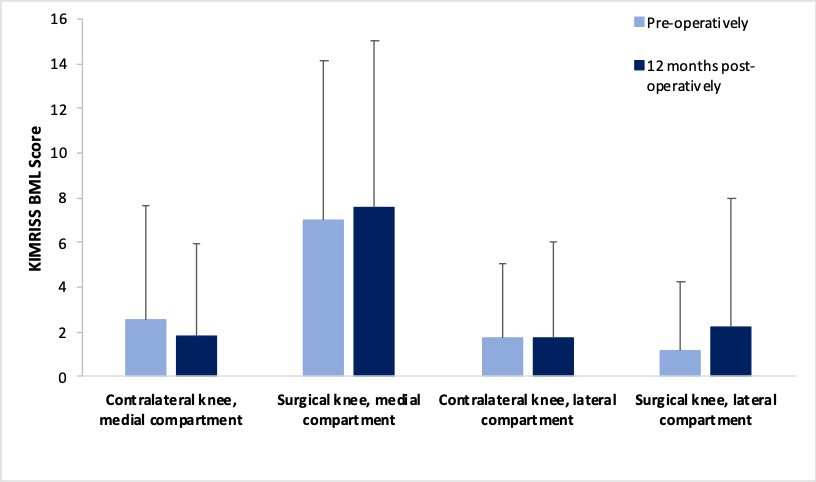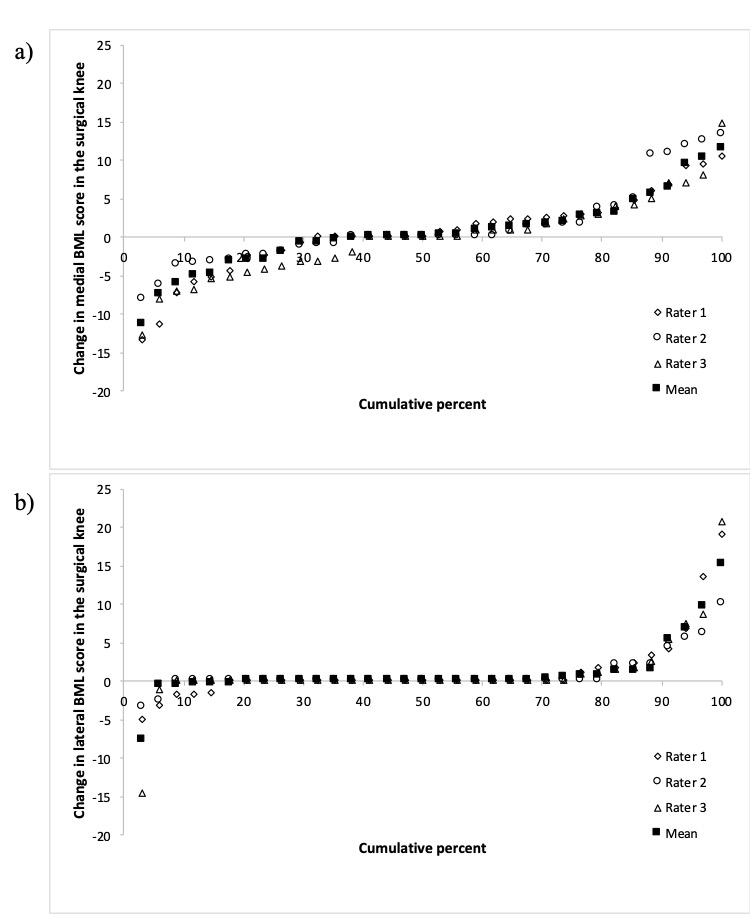Session Information
Session Type: Poster Session C
Session Time: 9:00AM-11:00AM
Background/Purpose: Bone marrow lesions (BMLs) commonly occur in knee osteoarthritis (OA) and are associated with increased risk of cartilage damage and pain. The Knee Inflammation MRI Scoring System (KIMRISS) is a semi-quantitative (score range 0-500) grading tool designed to evaluate features of inflammation in patients with knee OA. Therefore, we assessed 1) inter-rater reliability of KIMRISS BML scores between expert readers and a trainee reader before and 1-year BML scores before and 1-year after medial opening wedge HTO and 2) concurrent validity of semi-quantitative (KIMRISS) and quantitative (manual segmentation) measures of BMLs at baseline.
Methods: Thirty-four patients with varus alignment and medial compartment knee OA undergoing unilateral HTO were included. 3-Tesla MRIs were acquired of both knees pre and 1-year post HTO, after surgical removal of hardware. Femoral BML scores in the medial and lateral compartments were assessed on images blinded to limb and time by masking evidence of surgery. Three raters independently scored the same 136 scans (two limbs at two time points for each patient) using the KIMRISS. Additionally, one rater manually segmented femoral BMLs. Reliability of BML change scores in the medial and lateral compartment of the surgical limb were evaluated by calculating intraclass correlation coefficients (ICC) and Bland-Altman plots with 80% Limits of Agreement (LoA). Correlations between KIMRISS and manual segmentation values on the pre-operative surgical limb were evaluated using Pearson’s correlation coefficients (r).
Results: Descriptive statistics for KIMRISS scores are reported in Figure 1. The mean change in the surgical limb (± SD) was 0.54 ± 4.78 in the medial compartment and 1.00 ± 3.62 in the lateral compartment. Changes following surgery varied considerably but were detected by all three raters (Figure 2). When combining all three raters, the ICC (95% confidence interval) was 0.74 (0.59, 0.85) for the medial compartment and 0.71 (0.55, 0.83) for the lateral compartment. Paired rater ICCs ranged from 0.56-0.83. The 80% LoA was -3.57 to 5.44 for the medial compartment and -1.57 to 3.47 for the lateral compartment (Table 1). Paired rater LoA ranged from -5.07 to 7.70. Semi-quantitative and quantitative BML measures were positively correlated for the medial (r=0.54) and the lateral (r=0.39) compartments.
Conclusion: The KIMRISS can reliably detect small differences between femoral BML scores after HTO and can be learned by a trainee reader both efficiently and effectively. The KIMRISS BML scores are moderately correlated with scores from manual segmentation. These findings support the inter-rater reliability, concurrent validity and feasibility of KIMRISS compartment-specific BML scoring
 Fig 1. Means and standard deviations for KIMRISS femoral BML scores in the medial and lateral compartments for surgical and contralateral knees.
Fig 1. Means and standard deviations for KIMRISS femoral BML scores in the medial and lateral compartments for surgical and contralateral knees.
 Fig 2. Change after surgery in the femoral BML score in both the medial (a) and lateral (b) compartments of the surgical knee for all three raters individually, as well as the average.
Fig 2. Change after surgery in the femoral BML score in both the medial (a) and lateral (b) compartments of the surgical knee for all three raters individually, as well as the average.
 Table 1: Intraclass correlations (95% Confidence Intervals) (a,b) and 80% Limits of Agreement (c,d) for change in BML scores in the surgical knee in the medial and lateral compartments. Rater 1 = trainee, raters 2-3 = experts (one MSK radiologist and one rheumatologist).
Table 1: Intraclass correlations (95% Confidence Intervals) (a,b) and 80% Limits of Agreement (c,d) for change in BML scores in the surgical knee in the medial and lateral compartments. Rater 1 = trainee, raters 2-3 = experts (one MSK radiologist and one rheumatologist).
To cite this abstract in AMA style:
Schulz J, Birmingham T, Maksymowych W, Lambert R, Pritchett S, Beier F, Giffin J, Appleton T. Bone Marrow Lesion Scores in Patients with Knee Osteoarthritis Undergoing Tibial Osteotomy: Reliability and Concurrent Validity of the Knee Inflammation MRI Scoring System (KIMRISS) [abstract]. Arthritis Rheumatol. 2020; 72 (suppl 10). https://acrabstracts.org/abstract/bone-marrow-lesion-scores-in-patients-with-knee-osteoarthritis-undergoing-tibial-osteotomy-reliability-and-concurrent-validity-of-the-knee-inflammation-mri-scoring-system-kimriss/. Accessed .« Back to ACR Convergence 2020
ACR Meeting Abstracts - https://acrabstracts.org/abstract/bone-marrow-lesion-scores-in-patients-with-knee-osteoarthritis-undergoing-tibial-osteotomy-reliability-and-concurrent-validity-of-the-knee-inflammation-mri-scoring-system-kimriss/
